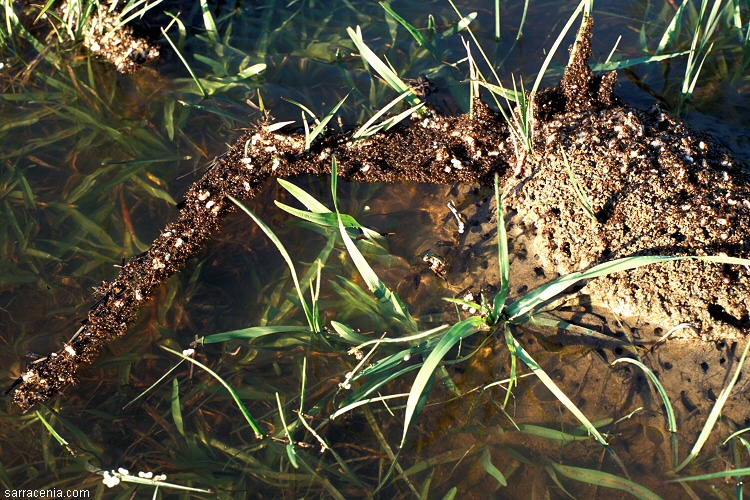
So here they are:
After taking this photo, I laid my camera gear on dry grass to study
the ants a little more closely.
Notice that in floods, they join together into big rafts, carrying their white pupae and eggs with them.
Sometimes (as I discovered), little clumps get dislodged and float
on the surface of
water until they find something to swarm up onto. Like your leg.1 This species of fire ant (Solenopsis invicta) is non-native, and has
significant environmental impacts by
reducing the native biodiversity of insects and other arthropods. Bad critters.
Gathering my gear, I discovered to my extreme displeasure
that the grassy mound supporting my camera gear was not dry after all, but
was actually hiding a few cm of flood water. Yes, my camera body was
partially submerged. I watched, in horror, as water drained out of the body in a steady stream. I opened the camera back and
discovered water in the film chamber, the battery chamber, and even on some of the electronics (the LCD display
started displaying insane, flickering messages, and the camera started beeping staccato R2D2 warning noises). Great sadness.
For the next few days, drying out and cleaning my camera body became a new hobby, but thank the great god Pentax, it was
all fine in the end and the camera doesn't even need repairs!
I retrieved Beth and we packed up the car: she, her art supplies; me, my
aqueous camera gear. We hydrated yet again, and headed east for Mississippi chattering about what we had
seen that we hadn't yet told each other about over the walkie talkies. As we drove, I clicked on my GPS whenever I saw
S. alata flowers lumenescing
in the gloaming. Next time, I'll give the Louisiana plants more time. There's always a next time.
Reading through what I've written, I'm struck by the aquatic theme: flood waters, water-filled camera gear, water-filled
pustules, hydrating naturalists. Water, water everywhere!
We had planned to camp in DeSoto National Forest that night, but again the dark caught us long before we got there.
Unsettling thoughts of another night of storms or masses of panicking, displaced fire ants gnawed at us. Our resolve
broke and we found a motel in the tiny town of Wiggins, Mississippi.
1Their painful stings evolve into in water-filled pustules. Mine lasted about ten days. Ich!